(Shirley Watts’ series of symposia entitled Natural Discourse, bringing scientists and artists into botanical gardens to make site-specific work, has taken on an even fiercer urgency seven years after its inception in 2012, as scientists and artists grapple with the real-time manifestations of climate change. MB Maher attended the most recent event and felt compelled to document it in detail, both photographically and in words.)
letter from sagehen creek field station
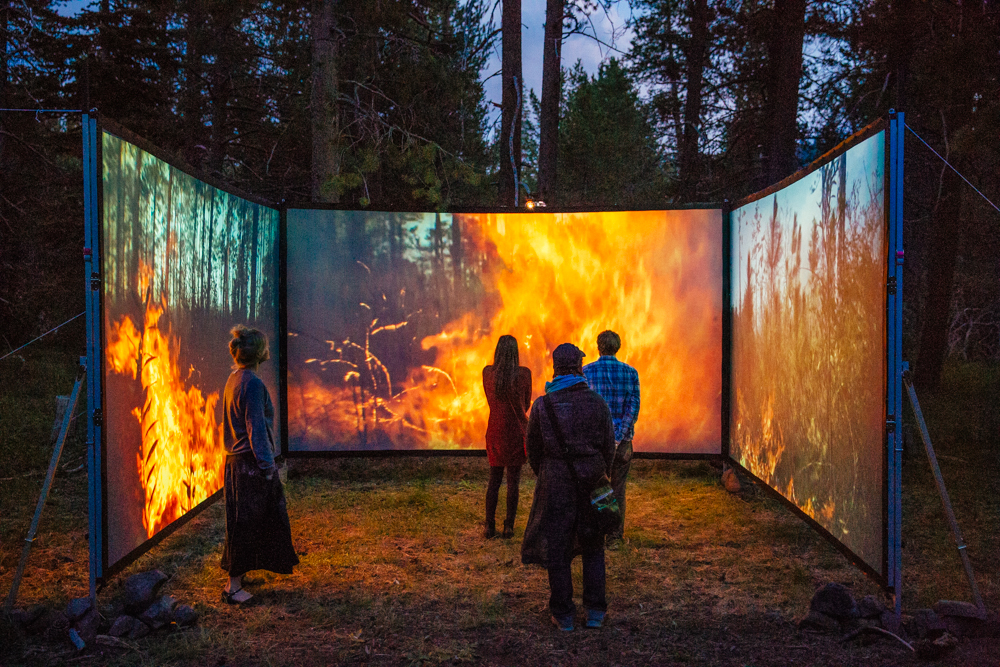
Mitchell Maher
August 9, 2019
Truckee, California
I drove into the forest without stopping at the local grocery and didn’t count on the miles of unpaved road that now separate me from the highway, from the town of Truckee, California, from mobile phone service, from anything but the almonds I have in the car & my stale baguette. The Sagehen Creek Field Station manages 9,000 acres of experimental forest at 7,227 feet in somewhat dusty isolation and I regret immediately how empty my water bottle is.
In the Field Station compound, I meet Shirley Watts coming out of a tool shed without a staple gun. I set it down somewhere around here, she says, and enlists me in the search while giving me a hug. She notices a patch of tomato seeds and juice on my white button-up. That’s funny, she says, I was just eating a tomato sandwich too. I definitely wasn’t eating a tomato sandwich, Shirley — I think this is yours. I point out an identical stain of tomato seeds and juice on her striped button-up shirt which was transferred in our embrace. She laughs and removes some of her stain with her thumbnail. Luckily you won’t be able to see much of this on my devil’s cloth, she says. (Watts wears mostly striped fabrics after reading Michel Pastoureau’s history of stripes, “The Devil’s Cloth.” Patterns where foreground is indistinguishable from background appeal to her, together with the long association of stripes with Satan, jugglers, prisoners, and the criminally insane — Shirley’s people. The bottom inch of her arctic white hair has been dipped in a stripe of black.)
Watts invented and began curating Natural Discourse showings in 2012 — bringing artists together with scientists and architects to shake loose truths of the natural world, the built environment, and the connective tissue, the poetry, of both. At first, these cross-pollinated group shows and symposia were flush with a radical insouciance; spiders were fed LSD and their drunken webs transcribed onto glasshouse panes (Gail Wight, 2012). But over many iterations hosted by California’s Natural History Museums and Universities, all nuance and subject has been taken over by the climate crisis. It was hard to find an artist or scholar who didn’t want to speak or make work about climate, Watts told me. The transition to advocacy was inevitable.

There is no fixed template for a Natural Discourse event, but the inaugural showing held at the University of California Botanical Garden at Berkeley showcased much of what Watts aspired to. Five speakers, eight artists, three architects, two poets. Overall, an insistence that landscape matters. And that these institutions – botanical gardens, natural history museums, parks, field stations – are not only integral to an American experience, but an ideal place to discuss our character and future. In the weeks before and after the show, a rotunda in the Ashby BART subway station took on cathedral dimensions when Natural Discourse artists printed clerestory window panes with transmissive photo imagery from the Botanical Garden. Video artists Nadia Hironaka & Matt Suib swept the 34 acres of the garden with infrared cameras and produced false-color hallucinatory films that screened on site from inside ivy-thick walls near the Palm House. The mood of the installations was celebratory and inclusive — the Larsen-B Ice Shelf had already dissolved, but it was still possible to live a life without the drumbeat of heatwaves, hurricanes, and carbon — an ignorance that isn’t available seven years later while Greta Thunberg sails into New York harbor as I write.
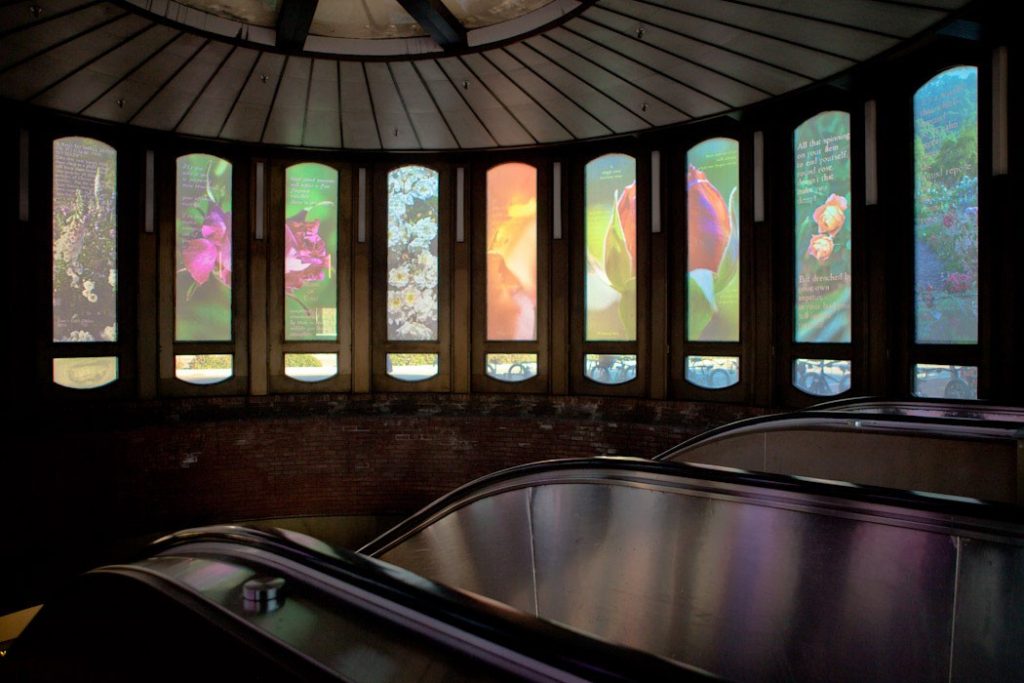
I was in the audience for the opening 2012 symposium, and the crackle of recognition between listener and speaker was — what I can only imagine to be — the branching current of Walter de Maria’s lightening field enduring strike after strike. Academics and designers and nonprofessionals touched off long fuses of concepts that sizzled throughout the day. Speakers who had never met or known of each other kept referencing each other’s material excitedly as the talks went on. Curator Bill Fox name-checked poet Hazel White at the lectern for the reading she had delivered hours before. Artists stood up during scholarly lectures and reminded attendees that their installations were only steps up the footpath & related directly to topics under discussion. Speakers one by one gathered all the threads of why we make and keep personal gardens – why we mix the tight control of our interior spaces with a wild unenforceable outer jungle. How we invent and maintain the porous boundaries of nature. To grid the planet, to make every centimeter knowable, is to take custody of a demanding and contiguous garden.
Concerns for architecture, design, and landscape are often described as frivolous, second-tier priorities. For this one unusual assembly of speakers and audience in a meeting hall in the hills of a botanical garden, the gaps between cartography, plantsmanship, visual expression, and philosophy of place were filled.
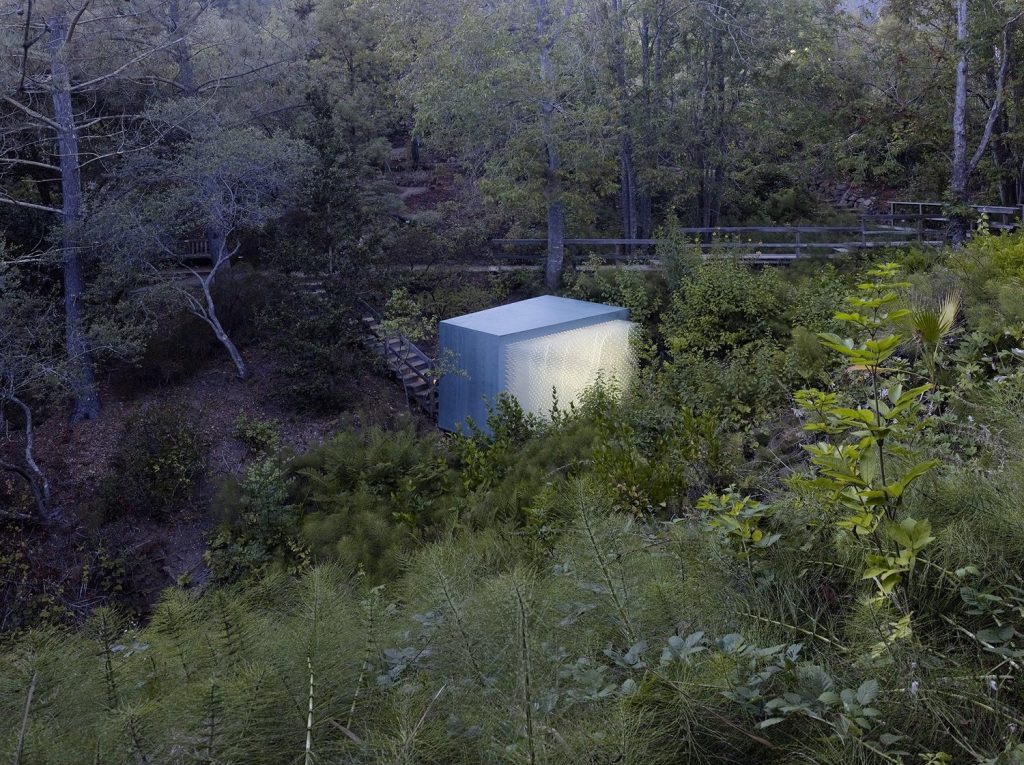
Even from nearly apolitical origins, this 2012 Natural Discourse managed to spark controversy and spent a few evenings as a punching bag on Fox News. Participating architects Ronald Rael and Virginia San Fratello cantilevered a small meditation chamber over the rushing water of Strawberry Creek with an entire wall made of optically perfect glass tubes to conduct the sound, cool air, and light from the creek inside. Thoreau’s cabin in Berkeley. Fox News seized on the SOL Grotto, as the project was known, fixating on the glass tubes. Originally from disgraced Obama-grantee Solyndra Corporation in Fremont, California, the tubes were fabricated as solar energy collectors, which Rael had intercepted en route to the dump after bankruptcy. Rael and San Fratello’s use of these glass tubes was almost incidental to the project, which focused more on beauty and contemplation than didactics or a history lesson. Nonetheless, they had political implications for Fox News contributor Greg Gutfeld, who, noting the failure of this Obama-era green initiative, memorably opined: “Most modern art and alternative energies are a lot alike in that it’s up to the believer to find value in it, because for the rest of us, there is none.” Almost a decade on, politics are not incidental to the work Watts has assembled for her new show at Sagehen; each piece is purpose-built and inescapably armed for a conversation with climate, set against the backdrop of a research and teaching facility in the Sierra Nevadas.
In August of this year, Watts invited 10 artists to interact with the Sagehen Creek Field Station and its research mission, to draw attention to its radical forestry (profiled recently in the New Yorker), and to mount a single night’s show for 125 invited guests. The artists will be on hand during the reception, but there will be no formal talks. I walk with Watts through the forest, finding the sites where this new group of artists have begun to install their projects, making sure they have the materials they need.
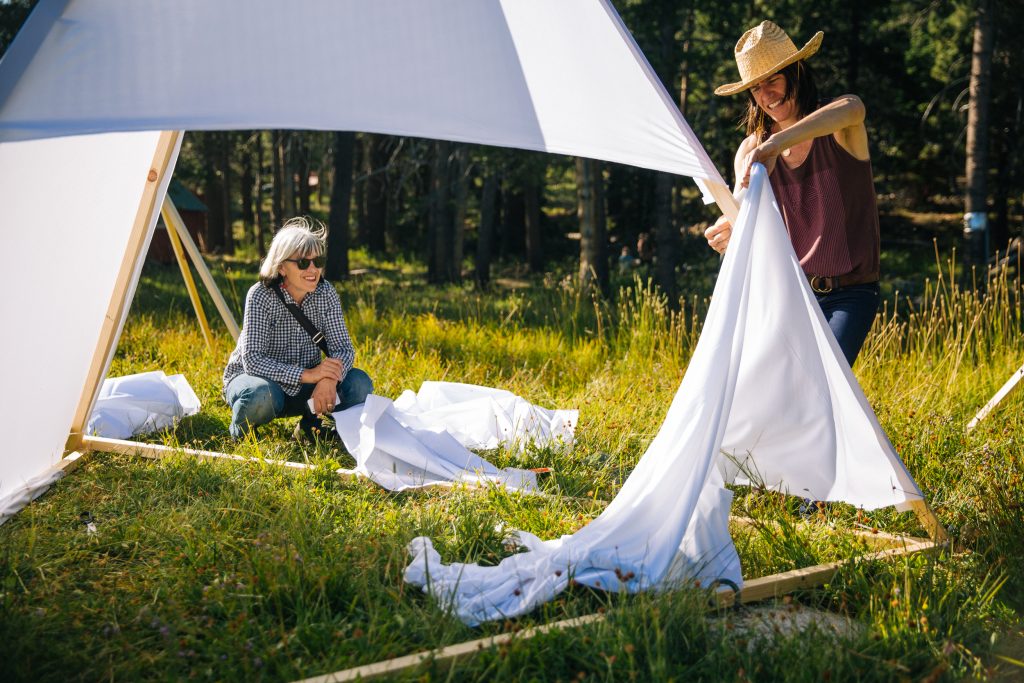
We find Watts’s staple gun in a meadow where Sasha Petrenko is using it to build tetrahedrons with plywood and nylon — Petrenko refers to the structures as tetra-SHE-drons and employs them in her performance as monikers of flame, the tetrahedron as the platonic solid closest to fire.
Petrenko – a Bay Area artist who bears such a physical and sonic resemblance to Patti Smith, it seems almost excessive to mention – has a long history with the Field Station through artist residencies and deep affection, once skiing into the research forest when 16 feet of snow prevented the drive. With spoken word, some melody, and an electric bass, “Lessons from the Forest,” the piece Petrenko is preparing for Natural Discourse lyrically itemizes human attempts to colonize fire, removing open flame from the forest (with the unprecedented success of Smokey the Bear) and putting it to work in numberless combustion engines. A team of dancers flicker around her in the meadow while she speaks. We’ve made great attempts to colonize fire, she warns her audience, but elements will not be colonized for long. And record temperatures will likely make our Anthropocene era better remembered as the Pyrocene. Petrenko and her dancers take their bows in a meadow dotted with sensors, antennae, and active climate monitoring equipment.
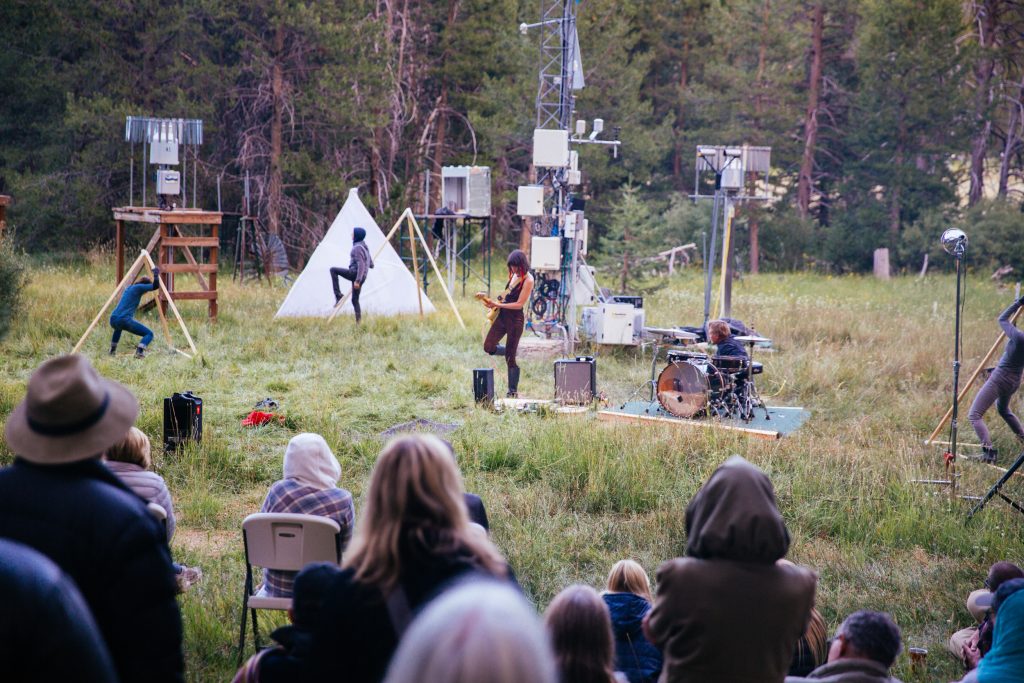
When I saw Patti Smith on stage in San Francisco, she performed “Gloria” as her encore — the song we all wanted to hear. The crowd went bananas. After she sang the last note, she shouted to the crowd, It’s an election year! You know what to do! But the crowd, strangely, went silent. We didn’t know what to do. Would we receive further instructions from Patti? Would she mark our sample ballots from the stage? Whiplash from the artist and her music to real world political efficacy had proved too discordant. And I think about this as Watts and I leave Petrenko’s meadow, putting distance between ourselves and her punk-inflected fire and brimstone.

As we walk past center camp, Watts pulls some incinerated books out of a biochar kiln she built earlier in the week for Jenny Kendler. This didn’t go exactly as it was supposed to, she says, arranging the black husks on a tray to bring them to their display site. The piece, Underground Library, chronicles Kendler’s collection of vintage (and ignored) global warming texts which she chars in a low-oxygen carbon-negative process and then buries to encourage microbial growth and lower soil acidity. Kendler does not fly, to better control her carbon footprint, and will not attend the Natural Discourse showing for this iteration of Underground Library. With Kendler’s instructions, the piece can be made anywhere by anyone, removing the need for the artist’s presence, which would result in high-emission jet travel. Owing to the elements at Sagehen, Watts adds extraordinarily evocative bell jars, and a few lead weights to keep the blackened pages of climate science from fluttering into the forest aboveground and defeating the purpose.
Kendler likens our century of carbon to an “economic death cult,” and I photograph this portion of her wall text with my iPhone. The books are actually disturbing, alone in the woods on their table, the worst nightmares of Ray Bradbury. And, of course, paperweights and bell jars notwithstanding, thousands of carbon crumbs lift off the table as I watch and ride the wind into the tall grass.
I mention Edward Burtynsky to Watts offhandedly, an anecdote about the photographer shooting his Hasselblad down through the floorboards of a small aircraft, and she interrupts me to ask why artists need to consume so many resources to make new work. Burtynsky’s plane, the gas in our cars to get to the forest this week, the untold resources burned to bring artists to the arctic. Why can’t we make work while burning less fuel? Watts asks. There are so few artists like Kendler who can reach out from their home base with conceptual work like these burned books, which Watts herself burned hours ago — I try to make the usual excuses for artists as witnesses, interpreters, primary sources who need to travel and experience the material in order to present the translation of it for those who can’t visit. Artists as our modern Marco Polo, bringing vignettes and reports of the crumbling empire to Kublai Kahn, who can’t leave the palace. But those explanations mean less and less among artists whose work is about resource management and who devote so much of their own energy to challenging mine.
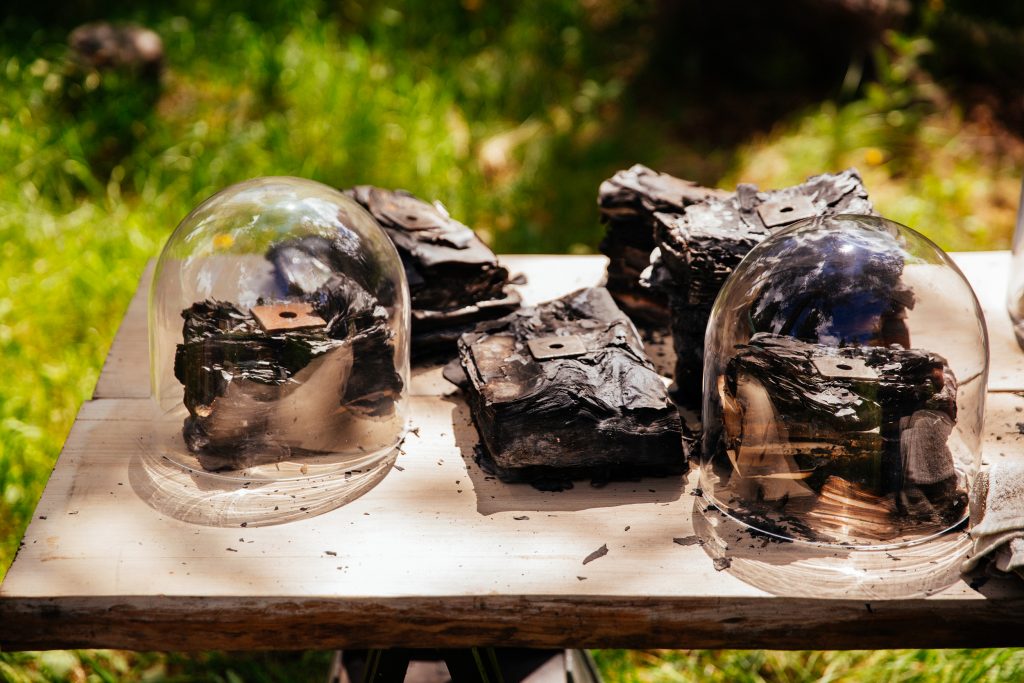
What happens when you set out to make art to save the planet? What is the distance between an artist and an advocate? When does advocacy become propaganda? When is rich, open work sacrificed for the quick read of a protest sign? Can polemic art last?
When Colin Powell made his case for war with Iraq in 2003, the U.N. Security Council staff threw a blue cloth over Picasso’s Guernica hung directly behind him. The chance of a screaming horse or a dying mother in lamp light appearing next to the Secretary of State in a television frame was too great a risk for the message he had to deliver. The Bush administration, for a brief moment, was frightened of a visual work. As an artist, how do you make work potent enough to frighten the government? Will only certain subject matter transmit the appropriate fear, or is the formula an open one?
Visual art about the climate crisis is unique in that its desired outcome is discreet; policy change. Lasting visual merit is preferred, but at this point it’s about raising awareness and changing votes in Congress. To this extent, fine artists have been drafted into the graphics department of a hastily assembled movement to keep our global warming below two degrees celsius. To keep our extinction levels low. A visual work is successful if it sequesters more carbon than it took to produce. By this metric, could Jenny Kendler’s Underground Library rival Guernica?
In a current profusion of gallery shows on ecology, place, and large climate data sets, Natural Discourse at Sagehen’s roster of all-contemporary artists and an insistence on staying outdoors and site specific is relatively unique. The New York Historical Society’s spring show, “Hudson Rising,” uses an extensive chronology of the Hudson River Valley School for an oil-paint time-lapse of water levels and shoreline erosion through the 19th century. “Nature’s Nation: American Art and Environment,” now at the Peabody Essex Museum in Salem, Mass., filters 300 years of American art through an ecological light; Winslow Homer’s bleak Civil War tableaus are used to showcase deforestation and burning of crops — tactics of both Northern and Southern armies with heavy ecological consequences. But repurposing or recasting the work of old masters to align with our new context and understanding of ecology runs the risk of generating insights aimed into the past. Watts has living artists on hand making work with fear in their stomachs and a sense of urgency. Work made under an existential threat has a decidedly different cast than any project undertaken in tranquility. One of the few direct corollaries this year would be the group exhibition at Storm King Art Center in upstate New York, (which also features some Natural Discourse artists), called Indicators: Artists on Climate Change.
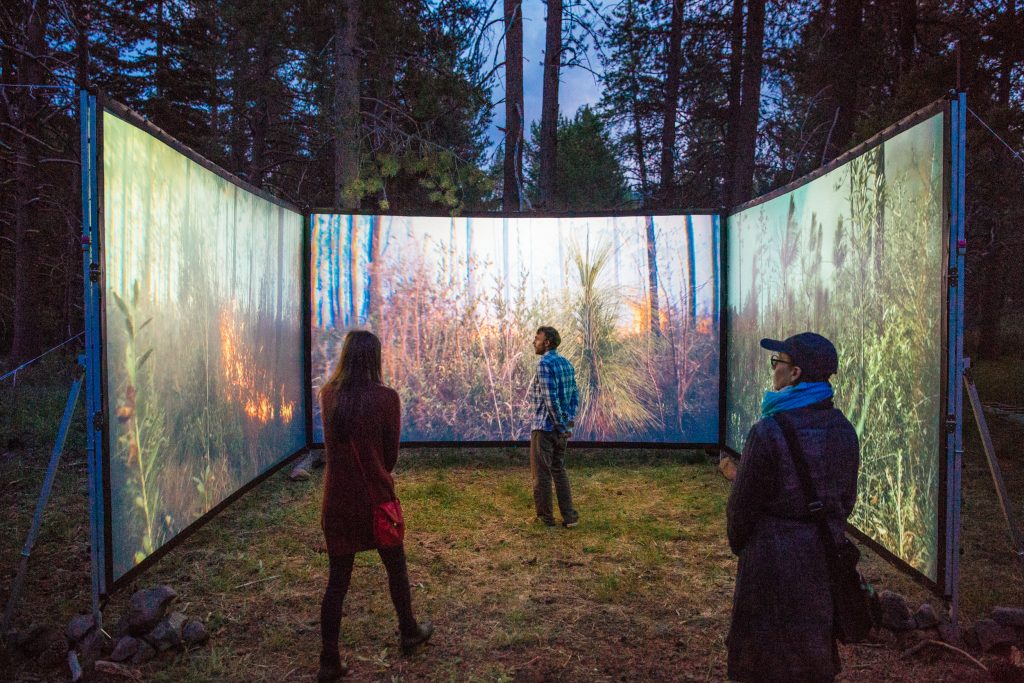
Ethan Turpin and Jonathan Smith have taken over another clearing not far from Jenny Kendler’s burned books and I help them tighten the guy wires on their tripartite projection screens. Turpin, the son of a fireman, speaks about wildfire as a perennially misunderstood object. Loss and transformation, on a scale we’re too short-lived to see as anything other than tragic, when in fact the ecosystem deploys brushfire like a farmer weeding fields — tragic if you’ve built your house in a thicket of weeds, but not dangerous to the forest itself. (Larger trees are insulated from low-level burns.) Generations of successful fire suppression turns out to be one of the larger and more dangerous impacts of human proliferation in the Wildland Urban Interface, the WUI. Historically, we have prevented too many fires & the system is pulled back like a slingshot. There’s evidence to suggest that pre-colonial Native Americans set fire to the forest as they migratedfor the season, using a conflagration to thin the forest & fertilize it for their needs next year. And that this fire practice took major burns from our current frequency of every three years to a remarkable 35-year frequency.
The video piece that will run across the three interlaced screens is called, “Walk Into Fire.” Turpin and Smith worked with the Forest Service to build and place fireproof cameras inside controlled burns in California to help understand fire behavior. While there was much trial and error, and Turpin lost more than a dozen cameras, the effect for a viewer inside the three-screen enclosure is that of a surfer ducking under a red hot line of shore break. The projections are slightly larger than life-size & together with detailed sound design create inescapable dread. I’ve had firefighters stand inside the projection, Turpin says, And the effect is so complete that I watch them get into their fire stance and angle their bodies to the line of flame. Turpin plans to keep capturing all of fire’s vocabulary – to make an encyclopedia of fire that we could learn from without having to live through it. But fire is also an aesthetic object, Turpin says. There’s a level of first-responder education and training in this fire catalog, but also beauty. Which Turpin sees as an access point for nonprofessional viewers, as well as an end in itself. He’d like his work to be as useful and as beautiful as possible.

VSCO’s vintage emulsion algorithms are part of my digital workflow. And later, in processing the photographs, I hesitate between curving the colors bright and ecstatic like Velvia, or muted and thoughtful more like Astia. Should a wall of fire projected into the forest be alarming or seductive? In making visual work on the cataclysm of a warming planet, if the work turns out beautiful is the cause betrayed? Can beauty take the teeth out of an argument? Or is aesthetic delight the best chance at distribution? Does beauty cause a viewer to overlook a troubling message? Do Edward Burtynsky’s photographs of ravaged industrial landscapes move us to action, or invite the talkative apathy of a normal gallery-goer?
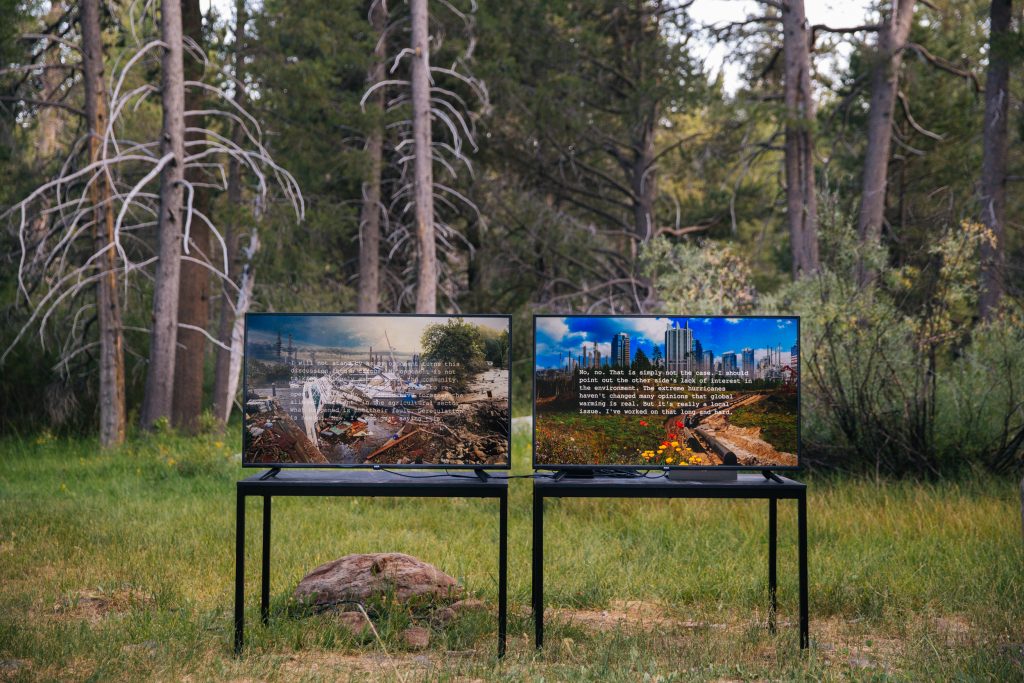
Because the science of climate change has been politicized and sidelined by less than good-faith arguments, reviving it & bringing it to the fore requires acts of advocacy that the discipline of science is structured never to need. And possibly recoils from. Which may be why climate advocates appear brash and unseemly, like self-righteous vegans. The nature of peer review and replicable findings in science means that there’s no place for championing a cause or arguing your way of thinking. The data speaks for itself. Unless the data is not allowed to speak.
David Opdyke’s never-ending and never-twice-the-same mutation of low-content sloganeering around climate policy showcases this process at work (“fair and balanced,” 2019). Through hours of parsing soundbites (initially on NPR while driving), Opdyke built a database of political-speak around climate policy and fed the stockpile into a script of code that mutates and reorders the phrases into an unending debate between two A.I. candidates represented by two facing LED screens. They say carefully curated nothing forever. With actual language heard on-air. To wit:
“My opponent has completely misrepresented my position! We are not here to talk about individual responsibility. Good, hard working folks built this dam together. No law could have prevented the detection of as-yet unidentified chemicals downriver. They just did what was necessary. Agencies must redirect their priorities. My opponent just has different priorities.”
The statements are so close to meaningless but so familiar in our discourse, it’s as if Opdyke has staged a Beckett play in Hades as sea levels swamp the theatre. The computerized mashups are even difficult to reproduce in text because their effect is a stun gun to the brain. The way current political discourse on climate ends up with less meaning than when it began. Which is Opdyke’s point. Nothing will be solved this way.
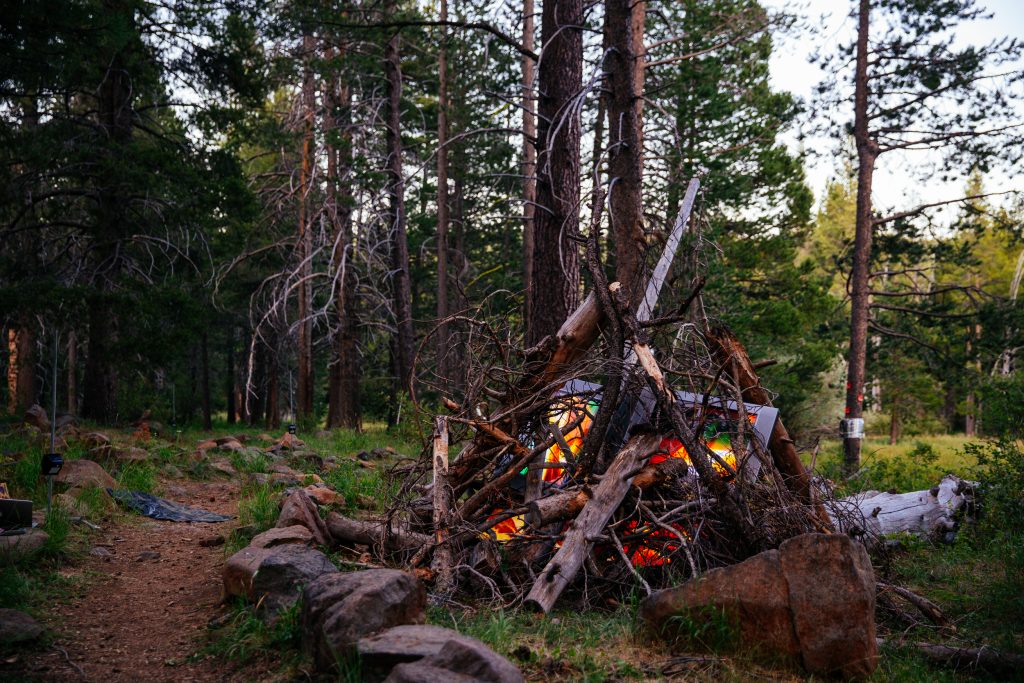
I hear Kevin Cooley’s Volkswagen van for 20 minutes on the dirt road into camp before I see him. Cooley has reliably made fire his subject for much of his photographic career, right up to the jaw-dropping image of a hillside ribbon of flame marching toward an American backyard foregrounded by a Hockney-blue pool and palm trees that ran in the New Yorker in 2018. I tore the photograph from the magazine and put it on my fridge, alarming the airbnbers. His piece tonight will be a rudimentary burn pile built with vintage CRT monitors screening fire footage (the experimental forest is dotted with similar burn piles, not made of televisions) with an audio crackle like a hearth.
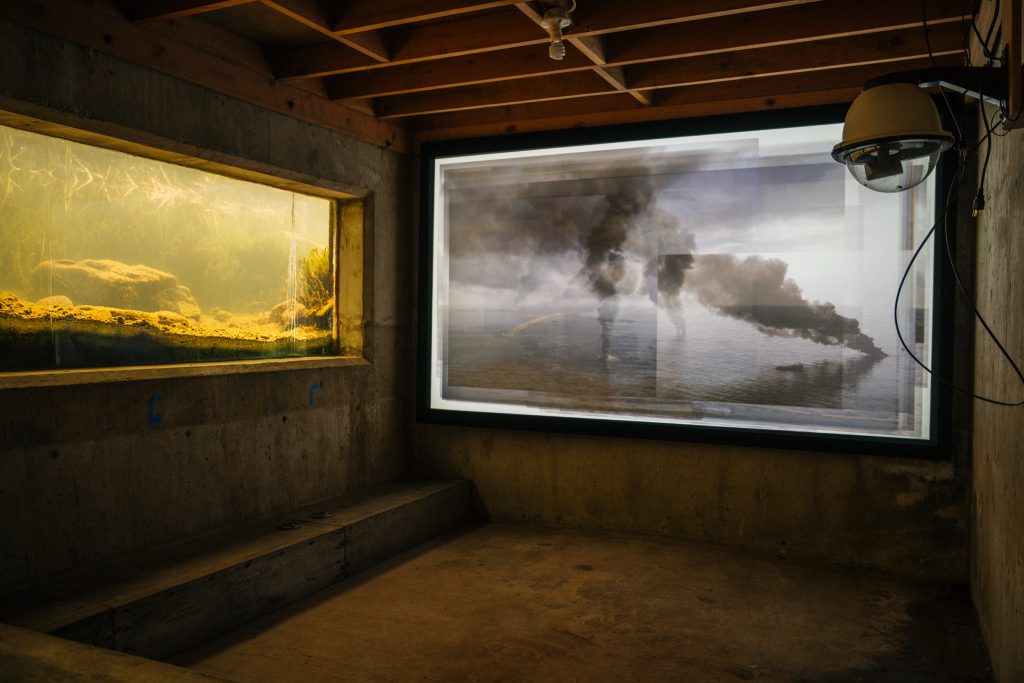
Instead of helping Deborah Orapallo install her projection screen in the Fish House (I don’t have the skills), I just stare out the windows into the creek while she finishes setting up. Orapallo’s video piece “Crude” (2018), will screen underground in the Field Station’s trout behavior viewing area built alongside Sagehen Creek. The temperature drops 10 degrees as you come down the wooden stairs and the viewing room is overwhelmingly damp and unsettling. Which benefits Orapallo’s piece tremendously. Andy Rappaport’s ominous bass-heavy sound design appears to ooze out of the bunker-thick concrete walls. Keeping a uniform horizon line, Orapallo layers photographs and seascape paintings one on top of the other fast like a dealer throwing down playing cards. Tall-ships sail up the Hudson on paint, drilling rig fires belch smoke on film. The piece could be a history of humanity’s love affair with the sea — although it would be more of an abusive relationship. Photographs of Huntington Beach flip by quickly — surfers up front on a pristine wave, oil rigs over their shoulders like wraiths. Impossibly, trout swim by the windows and linger while the video plays. I’m not kidding.

Jonathan Keats, a Bay Area surrealist and provocateur by trade, once genetically engineered God in a laboratory to learn where a deity might sit on the phylogenic tree (Keats found God closest to cyanobacteria (blue-green algae)). At Sagehen after dark, I watch him shoot abstract monochrome projections into the nighttime forest to stimulate photoreceptors of the assembled pine trees, who mistake his projections for the bliss of sunlight and become excited. Through trial and error, Keats has fashioned what he believes to be the ideal light-based caress — he’s not so much making plant porn as he is giving the trees a handjob. If I understand correctly. Regardless of sexual acuity, Keats’ shadow shapes act like cookie cutters on the forest, calling out single branches for their star turn — it’s rare and striking to see a stand of trees given light and movement after dark. In the past, Keats has set easels and paint in front of old growth redwoods and given them the chance to make art (they weren’t interested) — so it’s easy to imagine him reversing this process from tonight to make the trees the auteurs of very personal films projected back onto human viewers. What’s on the mind of a redwood? Would the films contain a fear of fire, or an affection for it? Who are the characters in a redwood production? Would humans make an appearance? Or are we too small and too quick to be seen on the timeline of a forest? This is the playground of ideas that Keats builds with very few moving parts.
Keats says, What I’m always doing is trying to pose thought experiments in the old-fashioned philosophical way – imagining from a radically different perspective circumstances that are very familiar to us, in order to make them unfamiliar and force us to start to pull them apart. So if your children are supposedly vegetating in front of the television when they watch it for hours, what happens when you show television to vegetables? I don’t have the answers, or I wouldn’t make the work.

When I meet Erin Espelie, she’s on a ladder installing a projector in the ceiling of the Field Station classroom. She’s taken the place over, blacked out the windows, and set out microscopes, vials of seeds, eggs, and specimens from the teaching supplies of the Field Station, most of which dates back to the 1950s. I’m fascinated by instructional taxidermy and before I’ve really gotten to know Espelie very well, I’ve opened a few more specimen cabinets and filled the room from top to bottom with the smell of mothballs, formaldehyde, and midcentury preservatives. Espelie feels faint on top of her ladder and excuses herself outside for fresh air and I am immediately ashamed. I’m so sorry I smoked you out of your own exhibit! I shout as she leaves. “Silent Springs,” the film Espelie will screen at Sagehen, is in honor of the 50th anniversary of the publication of Rachel Carson’s Silent Spring, which is sampled often throughout the piece, mostly with audio of Congressmen and paid scientists disparaging Carson’s methodology as scare tactics. Their ignorance feels quaint to us now, but just barely.
I ask Espelie about advocacy versus art-making and she’s very clear eyed. She says, Art isn’t going to solve climate change. Science is. But art can make people care. Make people interested. Art can open doors, introduce new ways of thinking. What we really need right now is a way to combat feelings of futility and feelings of ineffectuality, being too small to stop something that is so big.
One of Espelie’s art-making lodestars is the ‘Pale Blue Dot’ photograph that astronomer Carl Sagan asked NASA to make by turning the Voyager spacecraft’s cameras back toward earth as Voyager left our planetary neighborhood for good. Espelie says, Sagan recognized the power of art, in the context of science. He knew the impact this image would have on humanity, even if he didn’t know what the image would look like when he asked for it. JPL technicians laughed and said, ‘Only Carl Sagan could make that image interesting.’ Because, it’s like, where is the earth? Everyone thought it would be larger. The image doesn’t show a whole lot. Sagan poetically spun our minuscule blue dot in a shaft of sunlight into something beautiful. ‘Look how small we are…’ ‘Everything that’s happened in history has happened on that blue dot…’ Scientists know how important it is to create things that people want to look at.
There is a 20-minute window of twilight where the exposure of a television screen and the natural world are balanced — and a single firing of the shutter can capture both screen and forest without post production or strobe lights. For these 20 minutes every evening I am extraordinarily busy. Leading up to these 20 magical minutes, my workload is light. And on Friday night, I sit with the artist David Opdyke in a clearing at camp while he reads A People’s History of the United States and synthesizes a chapter out loud for me in which Howard Zinn describes the hollow and financial nature of our Constitution; that the Bill of Rights, the meat of our humanist liberal democracy, was a last-minute addition insisted upon by the states. We revere our Constitution as a powerful founding document, when mostly it concerns debt collections, taxes, and the priority of liens. The actual heavy lifting of democracy and human rights is done by a populist, grassroots, late addition to the document. Opdyke paraphrases Zinn for me from across our picnic table, basically reminding us that unless enough people get angry and mobilized and speak their concerns in a clear, strong voice, nothing gets done. Not even the Bill of Rights. Which is part of what all of these artists are doing in this experimental forest. To a very real extent, they are re-animating data, reminding us of 30 years of climate science, an unparalleled sense of urgency, giving us the raw material for the anger we’ll need to change policy.
Climate activist Bill McKibben wrote recently that the last fives minutes of the game are different than any other. You throw hail marys. You give up on the short yardage plays. You go for broke. These installations and projections in the Sagehen forest feel like a community of artists beginning to go for broke. To varying degrees, it is clear to all participants that there is no other subject any longer. For as long as there are materials to work with and time on the clock, our subject will be climate.
Regrettably, I’m the only one taking notes. Through a series of mishaps, poor planning, remoteness of the location, and tightness of the guest list, the letter I’m writing to you & the photographs I take are the only record of the show. This scarcity of documentation frightened me into the length and detail I apply to these projects and artists, at the risk of appearing a cheerleader. The prospect of letting these efforts, conversations, and temporary monuments vanish into the forest hits me on the same level as our great low-lying cities licked by storm surge waters. Document as much as you can and try to keep anything else from melting.
Sasha Petrenko has put together chicken tacos for the whole camp for dinner & I find myself heating tortillas with her in the mess hall over a gas flame. Her rehearsal didn’t go as well as she’d hoped and she’s missing one of her mic cables. She speaks about the stress of working with all new dancers and the limitations of her meadow performance space (there’s mosquitos). She tells me that her residencies at the Field Station and the forestry science she’s learned here have turned her into a finely focussed delivery system; I’m turning myself into the most compelling package for this information and this message on climate, she says.
Jeff Brown, the Field Station Chief, uses this chicken taco gathering to remind us to park all of our cars facing outward along the road. We’re on permanent fire watch here, Brown says, And if you hear me honking my horn at 2am you have to put your pants on and run as fast as you can. If you can’t outrun the fire with your car, Brown continues, Get a damp cloth over your face to cut the smoke and meet in the meadow & we’ll wait out the blaze together.
Watts and I catch each other’s eye during Brown’s safety talk. Did you hear that about waiting out the conflagration in the meadow? she asks. I nod. How do you feel about choosing this location for the show now, Shirley? I ask. This is the only place to present this kind of material, she says. If we don’t make this kind of noise, in this kind of place, why would policy ever change? When I had the idea to bring art to Sagehen, I first thought we would be projecting in the woods. Then I realized what was most compelling was the Field Station itself, the buildings, the research that happens here, issues of climate and the creation of doubt about scientific inquiry as a political strategy. We’re making work in the right place.
Watts will present another Natural Discourse group show in the Whittier Narrows Nature Center in East Los Angeles in December of this year. Participating artists include: Chris Doyle, Amabelle Aguiluz, Carolina Caycedo, Tanya Aguiniga, Chia Café Collective, Enid Baxter Ryce, Tim Durfee, and Rebeca Mendez. The website is naturaldiscourse.org.

The artist’s works show how all around us the climate is changing. While terrible weather events plague the world I believe people are finally taking the topic seriously and demanding change. We have faced dire situations before and when we all work together are capable of changing what seems the inevitable path. Thank-you Mitch for bringing this event to everyone’s attention.
I agree that art can be influential when it comes to the pivotal public policies of the day.
While I appreciate Shirley Watt’s position about bringing art directly to the scientists at the Sagehen Creek Field Station, I feel that taking at least some of it “on the road” to be viewed by a larger audience could be equally valuable, if not more so. In the era of social media, policy isn’t influenced solely by those who publish the words but also by interested members of the public. I can imagine that an installation of something like the “Walk into Fire” video piece could have a dramatic impact on the thousands of people that visit a place like The Getty for example.
@Elaine, I’ll pass on your kind words, thank you!
@Kris, you pretty much nailed why Mitch felt the need to document the event, to bring it to a wider audience. It was a lengthy piece but we felt it worthwhile.
Old post, but I thought you might all be interested to hear that Shirley’s remarkable Natural Discourse event was not a one-off, but part of an ongoing effort at Sagehen to help artists respond to forest management and ecology issues from an active platform.
For instance, Michael and Heather Llewellyn’s current exhibit at the Truckee Rec Center places the work of 19 artists–including 10 Sagehen artists-in-residence–in a busy public venue and in the historically and scientifically accurate context of the past, present and future of Sierran forests. It’s an absolutely impressive effort, with essays for each piece written by Jonathon Keats who is profiled in the post above.
The exhibit runs through fall 2022, then hopefully will travel. It’s free and the space is open every day (check the hours). If you are in Tahoe this summer, it’s a “don’t miss”!
https://www.nevadacountyarts.org/forestfire